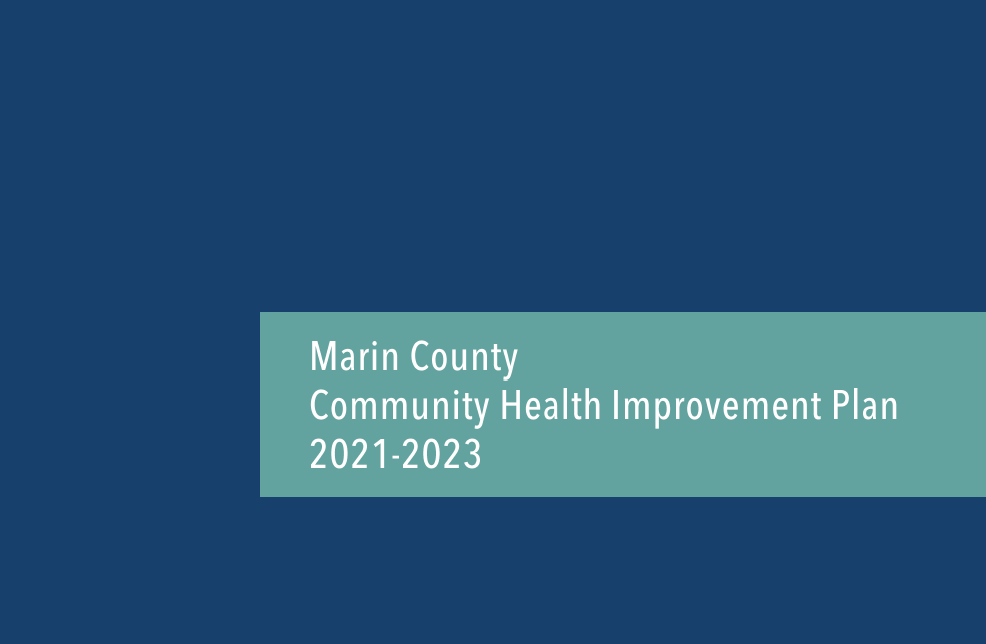Marin County has been long recognized as one of the healthiest counties in the country. Many Marin residents enjoy long life expectancies and good health status. More recently, a closer look at data has revealed significant disparities and inequities in health status and health outcomes. The burden of these disparities is largely experienced by Black, Indigenous, and People of Color (BIPOC). Wildfires in the region accompanied by extended periods of poor air quality and the COVID-19 pandemic have also brought to light that the health of Marin residents is strongly connected to the health of residents in the region. Marin is part of the nine Bay Area counties region with a commuting pattern that draws from many counties. Challenges with housing affordability have left many Marin residents with no choice but to move out of the county, continue to work in the county or return to the county to stay connected with family and friends.
Since 1996, Healthy Marin Partnership (HMP) has supported initiatives focused on improving health for all Marin residents. Through collaborative planning and joint priority setting, HMP has initiated signature efforts that have served as models. Initiatives focused on children’s health insurance coverage, collaborative approaches to Community Health Needs Assessments (CHNA) and Play Fair have set examples for what can be achieved when organizations come together with a sense of shared purpose.
Early in HMP’s formation, visionary leadership gave shape to a focus on addressing upstream factors impacting health. Over the years, HMP has been a convener and thought leader with focuses on primary prevention, identifying the critical importance of policy change, and embracing the Social Determinants of Health as central underpinnings of effective health improvement work. HMP members have been long-term investors and supporters of Play Fair, an effort that recognized that social norms are shaped in direct and indirect ways. These efforts led to the removal of alcohol industry sponsorship at Marin County’s annual fair. Long before population health approaches were brought into the mainstream health conversation, HMP member organizations were at the forefront of looking beyond outcomes at the individual level and valuing cross-sector collaboration to impact health outcomes for populations.
Over HMP’s 25-year history, the paradigm for what creates optimal health has changed significantly. Research, data and community voice point to the compounding challenges at the intersections of race, class, gender, gender identity, immigration status, age, ability and/or sexual orientation. Health equity is now standard language included in discussions of community health, and social determinants of health are routinely included in the design and implementation of successful health programs.
The past two decades have also focused more attention on defining health beyond physical health and medical care to be inclusive of mental health, addiction, and oral health. Health is also being viewed through new lenses that recognize that the absence of disease or illness can be a limited view of health. Concepts such as well-being and quality of life are increasingly being factored into contemporary thinking of what it means to be healthy at both the individual and community level.
Over the course of the COVID-19 pandemic, Marin’s healthcare sector in partnership with Marin County Public Health have worked together as a unified system with the singular goal to bring the pandemic under control. Throughout the response, Marin’s health sector has recognized the unique value and role of non-medical providers, particularly community based organizations, in ensuring that Marin’s approach is grounded in health equity. A strong alliance between Marin County Public Health and Marin County Office of Education resulted in Marin schools reopening to in-person learning ahead of most California districts and demonstrating that through partnership, schools can reopen with minimal risk of in-school transmission of COVID-19. The business community, led by HMP’s business representatives, has been a vital link in translating health guidance to the business sector and providing the business sector with the support necessary for safe operations throughout the course of the pandemic. The cross-sector relationships that had been established by HMP prior to the pandemic provided a critical foundation from which to mount a multi-sector response and has the potential to ensure through the recovery phase and beyond.
More recently, inequities in community conditions, health care access and high-quality health outcomes have been particularly amplified through the COVID-19 pandemic highlighting an undeniable imperative to focus on health equity and address directly the ways in which racism impacts health and mental health. The health sector is also being called to proactively prepare for and address the impacts of climate change which is already having a disproportionately negative impact on low-income communities of color evidenced by, for example, higher rates of chronic disease in regions with greater exposure to pollution and less green space. New community health models are also calling for change in how health equity is addressed by placing a greater focus on inclusion, and attention to community-driven approaches and partnerships, which requires multi-sector collaboratives like HMP to carefully consider how we design and carry out our work together.
Marin County recently adopted a Community Health Improvement Plan (CHIP). The CHIP builds on existing work in Marin by private and public sectors, with a targeted focus of improving health equity. This plan, designed in part for Marin County Department of Health & Human Services to meet Public Health Accreditation Board requirements, provides us with an opportunity to continue to broaden our approach to health and provide targeted interventions for needs identified through the triennial CHNA. The CHNAs are conducted jointly by Marin’s three nonprofit hospitals and Marin County Health and Human Services, resulting in a document which informs both hospital-led health improvement plans and the county-wide CHIP. Across Marin, there are a number of organizations and initiatives working to address health equity either as a direct or indirect focus; the most recent CHNA and CHIP process were revelatory in that stakeholder feedback called for stronger leadership from health institutions, strategic alignment of resources, and greater partnership between these institutions and community-based efforts in order to have a greater impact on health outcomes.
To that end, HMP proposes to modify our purpose as follows:
Healthy Marin Partnership is a multi-sector and multi-disciplinary collaborative that strives to advance health equity through joint efforts that are organized around a common vision and shared goals. HMP recognizes that health equity means every person who lives, learns and works in Marin has a fair and just opportunity to be healthy, and this cannot be achieved through siloed and disconnected efforts. HMP also recognizes that to achieve health equity, we must tackle the specific impact of individual, interpersonal and institutional racism on health and mental health. The complex challenges facing Marin residents require a deepened commitment to collaborative approaches centered explicitly on health equity. HMP affirms our commitment to addressing the social and structural drivers of health. We also acknowledge that poor health and mental health outcomes are shaped by racist policies and practices, both historical and contemporary. By leveraging our collective influence, power, and resources in partnership with community-based organizations and grassroots leaders, HMP is well-positioned to serve as a catalyst for meaningful improvement on health outcomes.
We select our focus through guiding principles developed to ensure the role of HMP is aligned across partners and prioritizes equity through short and near-term priorities. While our specific priorities and areas of work might evolve over time, we commit to working in alignment with the broad principles of a Community Health Improvement Plan, and in a data-driven manner using qualitative and quantitative data from the collaborative Community Health Needs Assessment to inform our community health activities and interventions. We believe that shared assessment and priority setting, community ownership, and accountability to continuous improvement is our vital asset.

















